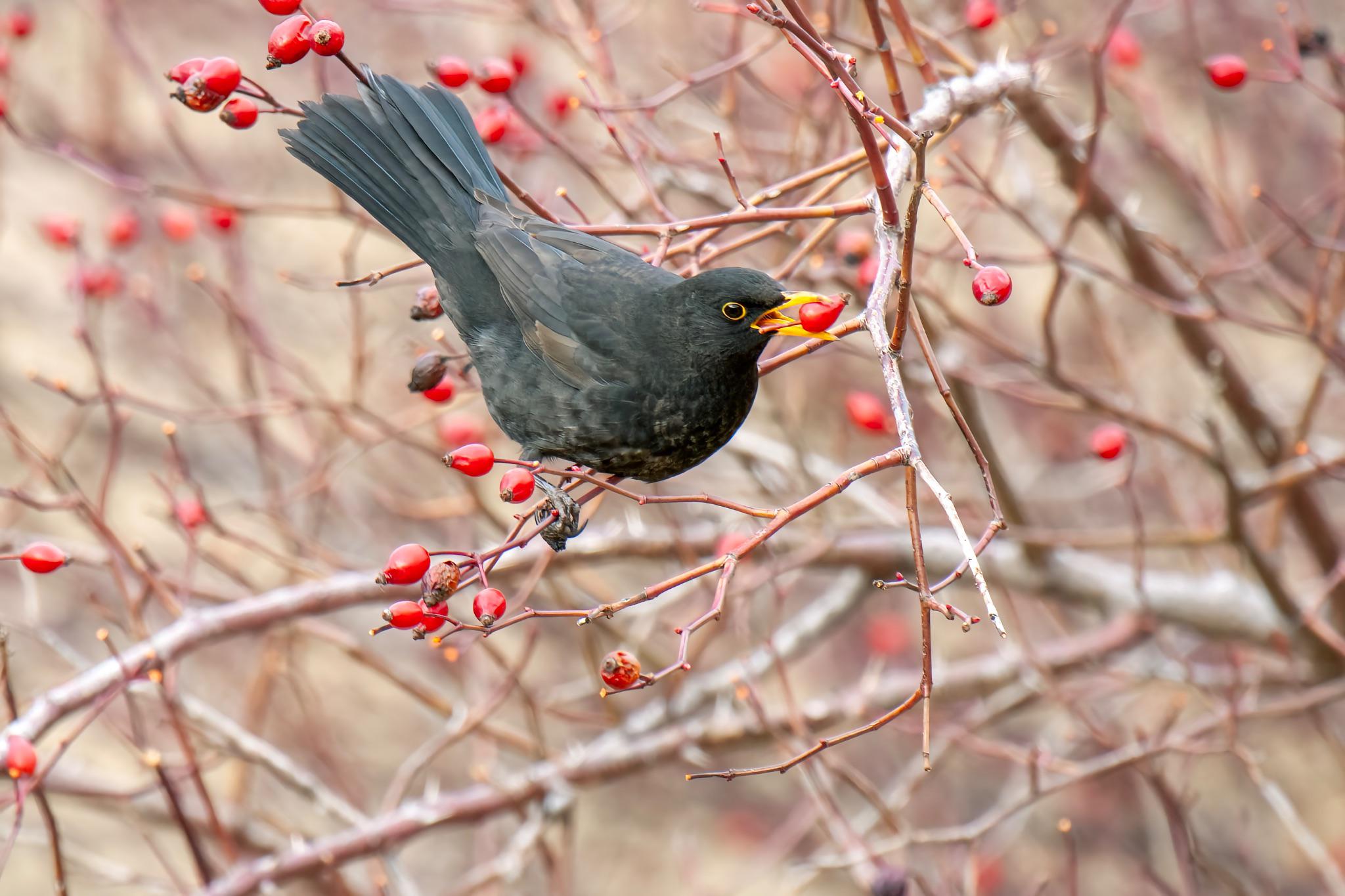Cómo las plantas y animales “construyen” sus interacciones: un estudio revela patrones consistentes de interacción en la naturaleza
En promedio, una planta individual recibe el 70% de la diversidad de animales que comen frutos en su comunidad y solo un porcentaje muy reducido de individuos desempeña un rol central en la red de interacciones.

Mirlo común (Turdus merula) consumiendo frutos de rosal silvestre (Rosa canina)
En la naturaleza, no todos los individuos de una misma especie son iguales: difieren en sus rasgos, comportamiento, interacciones, dieta, etc. Un equipo científico de la Estación Biológica de Doñana – CSIC y la Universidad de Sevilla acaba de publicar un estudio en la revista PNAS en el que se analiza cómo las plantas individuales de varias poblaciones estructuran sus interacciones con los animales que se alimentan de sus frutos. Los resultados observados en las interacciones entre individuos son similares a los obtenidos entre especies, lo que sugiere que existen unos patrones consistentes en la forma en que se organizan las interacciones ecológicas en la naturaleza.
Las plantas de fruto carnoso interaccionan con multitud de animales que consumen sus frutos y dispersan sus semillas, un proceso clave para la regeneración forestal. Por ello, a los animales frugívoros se les considera los “jardineros del bosque”. En la naturaleza, multitud de especies de plantas y animales, o mejor dicho los individuos que componen sus poblaciones, interaccionan entre sí y se conectan a través de relaciones mutualistas, generando así redes de alta complejidad.
Las diferencias que existen entre individuos de una misma especie se conocen como la variación intraespecífica. Los estudios que analizan este tipo de variación suelen abordarse desde la teoría de nicho, que estudia el conjunto de recursos que utiliza una especie y qué proporción de estos recursos que utilizan sus individuos. Estos recursos pueden ser tróficos, como presas u otro tipo de alimento, o servicios proporcionados por otras especies, como la polinización de las flores o la dispersión de semillas.
En este trabajo recién publicado, el equipo científico combinó la teoría de nicho junto a la teoría de redes complejas para estudiar cómo las plantas individuales de varias poblaciones establecen sus interacciones con los animales frugívoros que consumen sus frutos. Para ello, recopilaron redes ecológicas basadas en plantas individuales y la comunidad de animales frugívoros de 44 poblaciones distribuidas en Sudamérica, Asia y Europa, abarcando 29 especies distintas de plantas.
Una planta recibe de promedio el 70% de la diversidad de frugívoros
“Nuestros resultados revelan que, de forma similar a los estudios de dieta centrados en animales, en promedio una planta individual recibe el 70% de la diversidad de frugívoros existentes en la comunidad, lo que indica un grado de generalización considerable”, explica Elena Quintero, investigadora y primera autora del estudio.
No obstante, el equipo científico comprobó la existencia de una alta variación en el patrón de interacciones entre los diferentes individuos de una población. Así, dentro de la misma población, podían encontrarse individuos que actuaban como generalistas, interactuando con muchas especies, y otros que se comportaban como especialistas, limitándose a interactuar con una o pocas especies.
Además, con el objetivo de identificar patrones generales en las distintas poblaciones, el equipo calculó diversos índices de redes para explorar cómo las plantas individuales establecen sus interacciones con la comunidad de frugívoros. “Observamos que, en la mayoría de las poblaciones de plantas, independientemente de su especie o del ecosistema en el que se encuentren, solo un porcentaje muy reducido de individuos desempeña un papel clave en la red de interacciones”, explica Pedro Jordano, profesor de investigación en la Estación Biológica de Doñana – CSIC.
Estas plantas individuales, a las que denominan “keystone”, establecen múltiples interacciones con una alta diversidad de animales frugívoros y tienen un papel central en la estructuración de las interacciones dentro de su población y posiblemente en las dinámicas de regeneración forestal. Es probable que posean características distintivas, como una alta producción de frutos o ubicaciones estratégicas, que los convierten en recursos confiables para numerosos frugívoros”, explica Elena Quintero.
Este trabajo científico muestra cómo estudiar la naturaleza a nivel de individuos, permite comprender mejor cómo se organizan las interacciones dentro de los ecosistemas. Demuestra cómo las interacciones mutualistas se estructuran de forma similar tanto a nivel de especie como a nivel de individuo y en diferentes ecosistemas y biomas en el planeta, lo que revela patrones subyacentes y consistentes en la asignación de roles en la naturaleza.
Este enfoque más detallado no sólo revela patrones ocultos en las comunidades ecológicas, sino que también amplía la teoría de nicho hacia las redes complejas tales como aquellas que representan los mutualismos de muy alta diversidad que tienen lugar entre plantas y animales.
El estudio se enmarca dentro del proyecto de investigación “Evolución de la dispersión biótica en plantas: pasado, presente y futuro. Ministerio de Ciencia e Innovación” liderado por la Universidad de Sevilla y “The biodiversity of ecological interactions: from individual based interaction motifs to multilayer networks – MOTIFLAYER” liderado por la Estación Biológica de Doñana -CSIC, ambos financiados por el Ministerio de Ciencia e Innovación.
Referencia
Quintero, E., Arroyo-Correa, B., Isla, J., Rodríguez-Sánchez, F., Jordano, P. (2025). Downscaling mutualistic networks from species to individuals reveals consistent interaction niches and roles within plant populations. Proceedings of the National Academy of Sciences, 122(7), e2402342122. https://doi.org/10.1073/pnas.2402342122